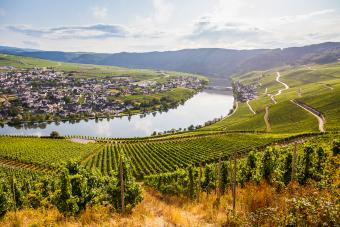
With long, difficult-to-pronounce names, Rhine whites from Germany may seem a bit intimidating. But the white wines from the Rhine Valley regions of Germany are delicious, approachable, and well-balanced wines that are definitely worth exploring. This Rhine wines list will help you discover these complex, interesting offerings from Germany.
About Rhine Wines
Rhine wines come from the valleys surrounding the Rhine River in Germany. The name, "Rhine wines," is not a formally designated wine region. Therefore, it loosely encompasses and refers to many of the white varietal and white blends that are produced along the valley, which spans across numerous regions within Germany.
The characteristically rocky soil and cool temperatures in much of the Rhine River Valley infuse the grapes with mineral notes and bright acidity. The wines can be single varietals or blends, and they can vary from dry to off-dry.
White Rhine Wines from Germany
Perhaps the best known of the white Rhine wines is riesling. While riesling is the major white grape grown in Germany, it isn't the only one. The Rhine River Valley also produces numerous other varietals that are made into white wines.
Riesling
Riesling is the primary white grape grown in the Rhine River Valley. There is a misconception that rieslings are always sweet. While there are several subcategories of German Riesling wines that are sweet, keep a look out for the word, trocken, on the label.
Nearly two-thirds of all German rieslings are made in this dry style. Even in the sweetest rieslings, the sweetness is tempered and balanced by mouth-ripping acidity and a pleasant minerality, causing the wine to taste crisp and refreshing on the palate. German rieslings are known for their flavors of apple and pear with delicate floral aromas. The wines are bright, crisp, and refreshing.
Müller-Thurgau

A widely planted grape in the Rhine, müller-thurgau is a cross between two grapes; riesling and madeleine royale. It is less showy than riesling, but is considered an easy-drinking table wine full of floral and fruity characteristics with less puckering acidity. With notes of peach, lemon and flint, this grape is a key player in Rhine blends.
Gewürztraminer (Clevner)
Gewürztraminer is a unique grape with its exuberantly floral, fruity, spicy characteristics. Tasting this grape ripe off the vine is a real treat because it is such a Discotech of flavors. Gewürztraminer is showy with obvious lychee and rose along with flavors of ruby red grapefruit and fresh ginger root. In the Alsace wine region and the rest of the world, it is more commonly referred to as gewürztraminer, whereas many regions in Germany call it clevner.
Silvaner
Silvaner is planted throughout the Rhine, but in smaller amounts than some of the other varietals. It is more of a shy-natured wine, with milder acidity and less pronounced aromas than riesling. Silvaner brings a juicy richness of peach and passionfruit with hints of wild herb to Rhine blends, making them ever-so-nuanced.
Weissburgunder (Pinot Blanc)
Weissburgunder, or pinot blanc, is a common grape in Rhine blends. However, there are plenty of single-varietal weissburgunder wines, as well. It's natural high acidity brings a fresh, crisp character to the blends and they typically have notes of pear, melon, and a slight salinity. Weissburgunder, in a blend or on its own, makes a great food wine and is a common bottle to see around the German dinner table.
Wine Regions
There are numerous tributaries to the Rhine River; these tributaries make up the many different wine regions within the valley. These regions stretch north to south, varying in geology and climate. Tasting wines from each region throughout the Rhine River valley is a transportive experience to a specific place and vineyard.

Mosel
This northerly region relies on the best vineyard sites with steep, southern-facing slopes to produce the high-quality white wines that have enough time on the vine to ripen. The rieslings from this region are acid-driven with notes of green apple and blossom. Weissburgunder is planted on particularly limestone-rich soil, while müller-thurgau is planted throughout Mosel.
Nahe
Nahe isn't a particularly large region, but the wines from here capture the distinct terroir well, and the region produces some of the best dry riesling in Germany. Vineyards here are widely dispersed and the lower-elevation vineyards produce aromatic müller-thurgau along with silvaner.
Rheingau
The birth place of riesling, Rheingau remains a prominent region for the grape. Here, the Rhine River flows more than half a mile wide at times, promoting mists that hang in the vineyards, creating ideal conditions for botrytis--a type of grey mold--in some years. Many of the wines from the Rheingau today are made in a dry style, and they are often fuller-bodied wines with riper fruit flavors compared to those of Mosel.
Rheinhessen

Germany's largest wine region, Rheinhessen spans across large, flat swaths of land and produces large quantities of grapes. The region produces a higher proportion of medium-dry to medium-sweet wines than other regions. Riesling is widely planted, along with müller-thurgau, gewürztraminer, and silvaner.
Pfalz
One of the most southerly situated wine regions, Pfalz vineyards see more sun and warmer temperatures during the growing season. Riesling, weissburgunder, gewürztraminer, müller-thurgau, and silvaner are all planted here, and express richer flavors from tropical fruit to vanilla.
Baden
Many of the vineyards in Baden are planted in a narrow strip, running 80 miles (130km) between the Black Forest and the Rhine River. Many of the white varietals are grown here, including müller-thurgau, which expresses a full character from the southerly climate.
Rhine River Wines
Germany's Rhine River valley wines are well worth taking the time to explore. Whether sampling a blend or searching out a single varietal, they all express their micro-climate well. When trying Rhine wines, sample different grapes, blends, and regions to find one that you like best.







